Swede Bend Lutheran Church
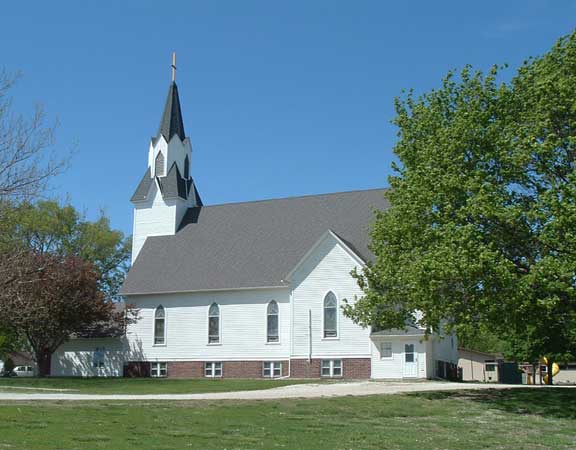
"All the immigrant Swedes who came to Iowa were baptised and confirmed Lutherans from Sweden. Some were not happy with the state church either because it intruded on their lives or because it fell short of their churchly ideals."
We began the last section with these same words as a reminder that the pioneer Baptists such as Palmquist, and Methodists such as Cassel and Linn began as nominal Lutherans, but were harboring the inclinations to "try something new." Now we turn to those immigrants who were less inclined to try something new, but to protect and perfect the ideals of their Lutheran heritage here in America.
For the Swede Bend community, there were special constraining circumstances. Peter Cassel, who was the prominent name in promoting immigration both to the New Sweden area and up the Des Moines river to the Swede Point / Madrid area was also an enthusiastic convert to Methodism. On the other hand, the first Lutheran missionary to Swede Bend was Palmquist, who soon thereafter converted to the Baptist belief and returned later under those colors. The organizing pastor of the Swede Bend Lutherans was to be M.F. Håkinson, whose early days in Iowa had been an ordeal of contests with each of the religious groups down in New Sweden. He was inclined to be tolerant and long-suffering, the characteristics not always present in his Lutheran successors.
The widow Dalander and her four sons and two daughters came upriver very early, in the 1840's to Boone county. They are said to have prospered, and the village of Swede Point was laid out on their land. Along with John Nilson, this family exemplified the Lutheran stalwarts. Two of the brothers ventured on to Swede Bend. They are of the mind to resist the many novelties of pioneer churchmen and with a group of likeminded immigrants, listen only to those loyal to the explicitly Lutheran faith. In about 1854 they request a visit from M.F. Håkinson to clarify for them the differences among the groups.
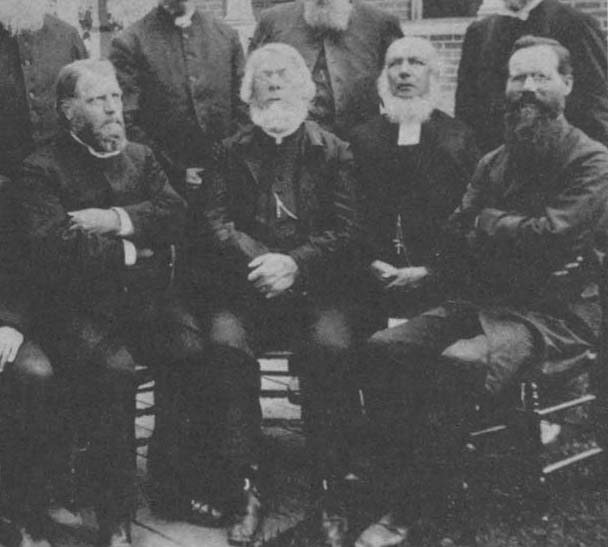
Augustana founders: 1) Erland Carlsson vied with Mission dissidents in Chicago,
2) T.N. Hasselquist in Galesburg, 3) M.F. Håkinson was first into Swede Bend,
4) E. Norelius calls it a "battleground": his brother Anders
was the first Baptist pastor there!
Norelius' history of the early settlements paints a picture of Swede Bend which goes as follows: the first gatherings for worship among the Swedes are clearly Methodist (G. Smith). Then follows the requested visit from Håkinson, and a large number enter their names on the list of those desiring to be "Lutheran." Subsequent to this, Cassel and Erikson come to correct Smith's perfectionist doctrines and by proclaiming that they are the "true Lutherans", undo the work that Håkinson had previously accomplished.
Smith then returns to plead his case, causing further confusion. Then the influence of the Baptists grows strong, and many of the same group is rebaptised. The Methodists sent Erikson and P. Nyberg in for the purpose of "bringing them back to Methodism." The picture that emerges is one of a single group of believers, and one incredibly torn by conflicting forces. Both the Methodists and Baptists form congregations, disregarding strong impulses to avoid the charge of "separatism."
In 1859 the loyalist Lutherans in the communities of Swede Point and Swede Bend call Håkinson to be their pastor. Later that year, he organizes a Swede Bend congregation of 40 members and in 1865 a church is built. We have no picture of this building, but one local source remembers it as being located to the north of the Methodist's (which had been built in '62) Whether the contested group had earlier met in the same building now surviving at Twin Lakes is an interesting question, one that we cannot now answer.
In 1867, Swede Bend Lutherans receive their first resident pastor, C.J. Malmberg. He has come through the Augustana Esbjörn school and is of the new, more confident and assertive generation of Lutheran pastors. At Swede Bend, he complains of the strife with competitive rivals on the field. (the words are "led nod"; "weary of troubles") We take note that a farmplace just north of town in the early atlas is registered to "C.J. Malmberg". Early records mention "eastern", "western" and "southern" branches of the congregation, and periodic meetings in schoolhouses presumeably serving the various regions.

A typical schoolhouse meeting place
In 1889, the Lutherans build a parsonage in town, on 5 acres they have purchased from H. Hanson. The 1918 map of Stratford shows this parsonage, the new church, and a small "chapel". What purpose this chapel served is something of a mystery. In any case, the new 34 x 60 foot edifice is ready for occupancy in February, 1894, having cost $3,396.39. This is the building still standing in Stratford.

Swede Bend Lutheran Site
But just as the Lutherans have established the boundaries between themselves and the Methodists and Baptists, they encounter an internal division.
The current crop of immigrants reflect the situation now developing in Sweden. The state church is struggling to accommodate the needs and desires of a newly awakened and increasingly literate population. The venues for these people are the lay leaders, called "colporteurs", their mission chapels and mission meetings. Their ideals are temperance, devotion to the Scriptures and an emerging style of singing and conversation about these new things. Since these are the conditions in Sweden, those now coming to Swede Bend envision a similar situation here in the new world.

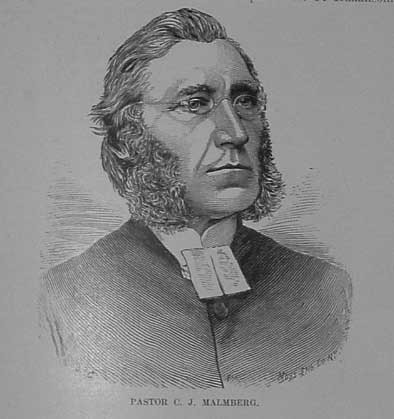
Björk and Malmberg, leaders divided at Swede Bend
So it is, that when H. Blom comes to Swede Point in '66 and C.A. Björk joins his brother Rustin in Swede Bend in '64, they become lay leaders working with Pastor Håkinson among the mission-minded members. Just as Sweden had regional associations of the mission groups, a Lutheran Mission Association is formed in central Iowa. It would ultimately include not only the above communities, but the mining community down at Moingona and Ogden. In each case, the groups are auxiliaries of their Augustana congregations. This association in 1870 hires C.A. Björk as their "respredikant" (traveling preacher) for $400 per year. This would augment his earnings as a shoemaker in Ridgeport, south of Swede Bend.
He is later succeeded in this position by A.W. Hedenschough and then G. Norsen, now receiving $500 per annum. The next colporteurs of the association are J.F. Gillberg from '78 to '83, and C.B. Johnson who supplied this information to the editors of the 1910 "Missionsforbundet Missionskrift". They have subsequently extended their ministry to school and home preaching stations at such places as Lost Grove and Pilot Mound. The parallels with the Jonköping Mission association have been clearly drawn by these memoirs.
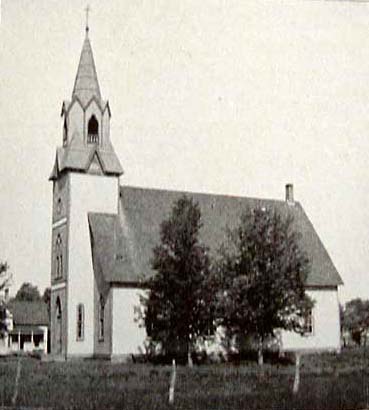
Swede Bend Lutheran
original home to the Mission Association
By pointing to these facts as he does, perhaps C.B. Johnson is underscoring the character of the mission association as a loyalist, and not a separatist-minded entity. Björk and the Swede Bend mission association have seen first-hand the examples of the separatists: the Methodists and the Baptists. They have joined with neither, and yet there is something different about the "lay of the land" in America. These rivals have painted the Augustana Lutherans in dark colors; saying they mean to bring the Swedish state church to this country, with all of its oppressiveness. They are discouraged when Augustana policy closes its doors to their preachers, for it seems to validate the arguments of the separatists.
Even in Sweden, the mission movement had taken on a new independence. The old ENF, the establishment organization, was supplanted by the new Missionforbundet; more independent, growing, less constrained by laws and customs. The newer immigrants such as C.A. Bygel and the families coming with him were ready to make more of the "missionhus" than an auxilary to the Augustana Synod. They were ready, perhaps fated, to become an American denomination of their own. Ultimately, the breach became complete. Swede Bend is a case study in just how the events came to be.
"Dr. Norelius in his history of the new settlements calls this one a battleground. And this is true, sofar as those days are concerned. The people, as far as the Swedes are concerned, are divided in different groups. Many stand without any church relationship, and a sad fact is, that most of these belong to the Lutheran congregation here...yes many of them have grown up and been confirmed in the lap of this congregation"
These words written from a later Augustana perspective are a backdrop to this look at the past and present situation in Swede Bend. We wonder what Norelius would say if he could see today the directions taken by the Stratford and Callendar Lutheran Churches in deciding to leave the ELCA, heir to Augustana, and join a group called the LCMC? Would he wonder if there is "something in the water" in Swede Bend?
Here is the description of this "LCMC", which has separated from the ELCA:
......................................................................................
Lutheran Congregations in Mission for Christ is an association of congregations and individuals who are:
-free in Christ;
-accountable to one another;
-rooted in the Scriptures and the Lutheran Confessions;
-working together to fulfill Christ's Great Commission to go and make disciples of all nations.
LCMC is an association of congregations. We have a great respect for the reality that the church is where the people of God gather together around Word and Sacrament. The local congregation is where the church becomes a concrete reality for God's people.
At the same time we are joyously aware that each congregation is a part of the greater body of Christ. The actions of each congregation within our association reflect on our association as a whole. And the actions of our association reflect on the whole body of Christ. For this reason we have committed ourselves to a common set of ministry standards.
Congregations have significant latitude in ordering and shaping ministry in their local setting, and we intentionally have made joining and leaving the association simple. We have also agreed to a disciplinary process for addressing congregations whose actions violate our agreed-upon statements of faith and practice.
.............................................................................................
The Swede Bend congregations which are now LCMC are as follows:
Our Saviour's Lutheran Church
504 James St
Callender, IA
Pastor(s):
Pr Kent Wallace
Baptized: 415
Confirmed: 310
Average Attendance: 139
Mail: PO Box 188
Callender, IA 50523
...............................................................................................
Stratford Lutheran Church
818 Teneyck Stratford, IA 50249
Pastor(s): Pr Joseph Lambert
Mail: PO Box 79
Stratford, IA 50249
The word "Mission" stands out in the title of the new group. Norelius would be very familiar with that slogan, since it was also common to the last large defection from Augustana ranks in the immigrant days. (Mission Synod, Mission Covenant, Free Mission) And the reference to "free in Christ" would strike a similar chord.
But over a century later, the situations can not really be compared. More apt would be to compare it with the instincts of an Esbjörn, who shyed away from American Lutheranism in the form which he found it in mid nineteenth century. Both then and now, the church that is built and shaped into something large and widespread can fail to satisfy some needs in some parts of its membership. Has history repeated itself?
We stand with those who hold that the character of the early Mission Covenant church was Lutheran in nature. But so far is this from being obvious that only a careful review of these facts of history can affirm it. So it is that we intend to spend some time discussing this question.
In this telling, we have not repeated the well-worn account of someone hiding Björk's copy of Pietisten, so that he was forced to extemporize and reveal his evangelistic gifts at Swede Bend. (We doubt Björk liked this story any better than we do) Not that it may not have been factual, but the real story was more nuanced: more in the style of C.B. Johnson's telling.
For another angle on Björk, we draw on C.V. Bowman's memoirs. While he is assisting Björk at the North Side Mission church in Chicago, Fredrik Franson is conducting his missionary training sessions around the country. Franson presumes to announce in the press that he will be holding session in Chicago at the North Side church. Bowman glosses over Björk's refusal to allow Franson access to his church; the sessions must relocate to Skogsbergh's South Side Tabernacle, then served by Pastor August Pohl. Here is the story:
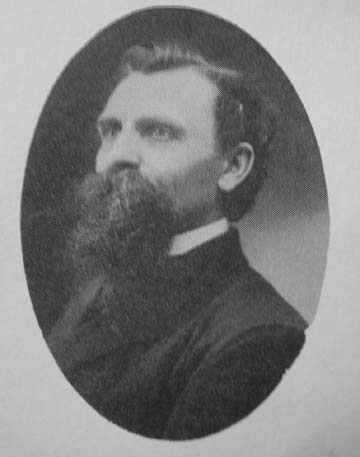
Swede Bend visitor, F. Franson
"The late missionary, F. Franson , who had previously resided in Chicago for a time and participated in the so-called 'prophetic conferences' among both the Americans and the Swedes, had now returned from a stay in Sweden and other European countries. He had been sincerely griped by a distressed call for help from missionary Hudson Taylor requesting from among Christians in all parts of the world a thousand new missionaries for China. Now Franson decided to awaken interest in this cause among our Swedish people in America also."
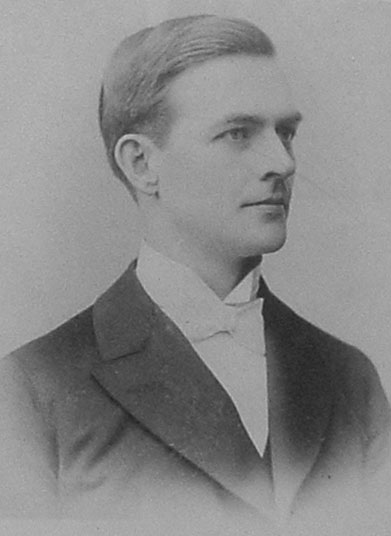
Björk's assistant, C.V. Bowman (later Covenant president)
"He sought to arrange so-called missionary and Bible courses to be held for a few weeks each in different cities of the country. He began with several such courses in the eastern states and then announced in newspapers that he intended to hold a course in the Mission church on the North Side of Chicago, but since he had neglected to first ask Pastor Björk or the congregation for permission to use the church, the announcement caused dismay. Franson's neglect or arbitrariness, whichever it was, did not sit well with the members of the board, much less with Pastor Björk.
The question of whether Franson should be allowed to hold the intended course in the church was now on the agenda of the board meeting. Most of the brethren, with Pastor Björk as leader, felt that the church should not be open to him. Their contention was that it had never before been opened under such conditions and should not be so at this time. But others felt that Franson's improper action should be overlooked inasmuch as he was inspired by a good cause. I aligned myself," continues Bowman, " with this group, perhaps a natural decision since I was the youngest and understood perhaps least of all the importance of the question and the wide ramifications of the board's decision.
...Missionary Franson made common cause with the so-called 'Free' people who at that time criticized the Mission Covenant vehemently. Pastor Björk was, of course, the president of the Covenant and the church belonged to it."
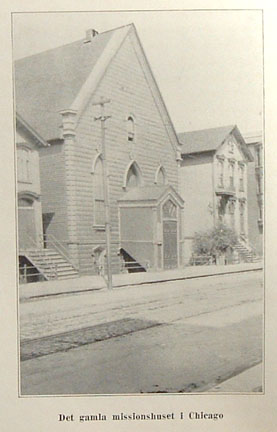
The Chicago Missionhus
What Bowman may never have known, and Björk might typically have remained silent about, was that he, Björk, had already seen Franson in action at Swede Bend in '77. During those revival meetings which we covered above, the Baptists and Methodists are mentioned as adding to their congregations' numbers. The Lutherans and the Lutheran Mission Friends are not mentioned. We may surmise that this sort of thing was "not their style." Here follows one account of Franson's visit to Swede Bend:
"In February, 1877 Franson, at 24 1/2 years of age, began his first public campaign as an interdenominational evangelist at Swede Bend, Iowa. Fifty four years later Miss Minnie Lund, the local school teacher and organist, penned this eyewitness acount:
The greatest revival ever witnessed here was conducted by evangelist Fredrik Franson who came as an undenominational missionary sent out by the Samson Mission of New York (sic)...Crowds to overflowing gathered at both churches. Even standing room was at a premium. Nevertheless, people flocked in from all directions. Many of them walked several miles through swamps and thickets but none could stay home in the midst of such outpouring of God's spirit.
The evangelist also brought a singer which added to the interest. Good singing was such a treat, and he surely sang the Gospel into the hearts of the listeners. He also led the audience to sing -- and such singing those people did! At both morning and evening services one would think the heavenly hosts had come again to visit the earth as they did at Bethlehem on that first Christmas morning.
These special revival meetings were held in February 1877 and continued for several weeks. There were many additions to both churches as a result."
"both churches?" We have assumed that Miss Lund is speaking of the Methodists and the Baptists (Franson began as a Baptist). But could the Mission people have missed such an event? Hardly. Though the Lutheran hierarchy was on record as opposing such campaigns it may have been a pivotal moment for the Lutheran Mission friends. And, if Mission people did participate, how did Björk view the situation? What we know is that within the year he accepted a call to the North Side Mission church in Chicago. Beyond that we can only speculate.
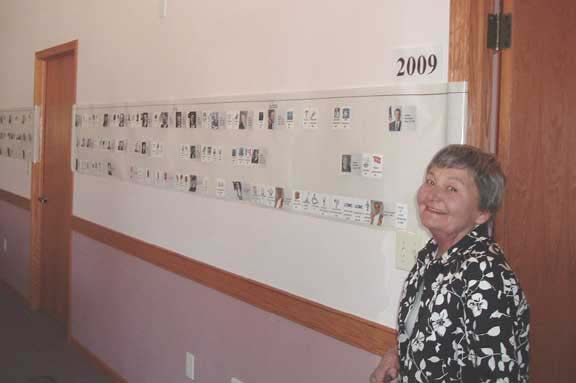
Carol took time to show us inside Stratford Lutheran
This is her historical timeline for Sunday School instruction
Good Job!
Björk got along fine with Pastor Håkinson; they were both shoemakers after all, but his successor Malmberg took a dim view of the Mission people and their association. It was not necessarily Björk's desire or intention to separate from the Swede Bend Lutherans, but circumstances were forcing change.
One of the most difficult things to understand about the mindset of the devout immigrant has only slowly become apparent to me. That is the lingering reality of the "old world"; that the very land and people are God's, and that the king, reigning by God's will, authorizes the Christian Church and its structures according to divine purpose.
In other words, "the established church" meant very much more to the mind of the immigrant than we today can imagine. When we, in the land of separation of church and state, repeat the words "one nation, under God", we are expressing an abstraction that would have been a pale image to immigrants. They came from a place where "under God" was constitutionally structured and administered everywhere in their daily lives with the same diligence that the U.S. government's administration exercises in ours.
The devout immigrants' demonstration that they in no way intended to "leave God behind" is clear in the efforts they put forth to build congregations and churches in America. There is also the abhorrence they generally showed toward "separatism", which in Sweden was an illegal and despicable thing. It might be possible to frame the development of the Swedish denominations in America along just these lines: how quickly each group was able to overcome this distaste for separatism and adopt to the voluntarism of the new "freedom of religion."
According to this framing, the Baptists and Methodists would have been the first to accept the new order, though in every account their American friends had to make considerable effort to convince them that it was acceptable to good Christian order for them to thus affiliate, and that there would be no betrayal of their Christian roots in so doing.
This was complicated by the persuasion of the immigrants who associated with the American Lutherans or otherwise labored to gather under a Swedish Lutheran banner in the new land. They accused the Baptists and Methodists of exactly what they might have feared themselves: that they were indeed separatists and betrayers of the most holy faith! It was indeed a troubled time.
To spell out this situation further, the matter of clerical authority played an important part. The credentials of the clergy in Sweden were well established by firm structures and long tradition. True, there had been a slight blurring of the lines by the rise of the mission colporteur in the mission societies in Sweden. And there was also the phenomenon of what we might call "charismatic" leaders; prophetic figures who gained a following based on their own "visions". This would not be surprising in the Swedish folk culture with its well-known susceptiblity to superstition.

The radical Bishop Hill commune: a fruit of "separatism"?
But these things were the exceptions. The bulk of the immigrants had a sober and serious view of their faith, and they were very reluctant to be associated with novelties such as these. All were aware of the weaknesses of the state church; most would hope that these weaknesses could be reformed and refined without an overthrow. But what had this to do with this confusing new "land of liberty?"
And yet another critical factor to be considered: what of the "means of grace?" Tradition drew a more or less direct line beginning with the heavenly source of all grace, to the office of the earthly regent, to the official church established in the nation, to the duly ordained minister of the local parish (effective regardless of that minister's own personal merits) and finally to the faithful and observant member of the congregation.
To imagine that this ancient tradition could be circumvented by some other means, that some self-appointed layman might stand at the altar of holy communion, or apply the rite of baptism, was pretty much unthinkable. If some of the novelties cropping up in Sweden made the faithful nervous, it in no way compared with the lurid practices the immigrant could observe among their new American brethren!
Alongside the matter of the "means of grace" is that of the way in which this grace is received. The ancient tradition with its "direct line" left little doubt in its effectiveness; no matter that the recipient of baptism might be an infant, little doubt in the communicant at the altar rail that this venture so close to the holy place and its ministrant would be anything less than effective. But in the new land of "voluntarism" this voluntarism would extend even to religious practice.
Now, the crux of the matter was in the will of the believer. Not whether the person had received the sacrament of baptism, but whether he or she had been "converted". In the Baptist view, only upon such conversion was the baptism effective. This new teaching, along with the denominational system, were the two most significant factors for change in the Swedish immigrant church.
Those who might have felt most keenly these matters were the very persons among the immigrants who found themselves in the positions of leadership in the congregations. In Iowa, it was Blom and Björk; John Peterson, Norsen and others. To those of us who have never given a moment's thought to the validity of "denominations", who never lived under an "established church", their discomfort is hard to imagine. But their reluctance and hesitancy, or, if you prefer, the deliberate direction of their efforts, gives evidence of the fact.
Some Mission historians simply describe their congregations as first of "a new denomination"; characterize their meetings together as the first of "a new ministerium." That would be a rewriting of history that obscures reality in retrospect for us, who are little able to judge critically what was the case. It should be noted, that some of these historians are really using the terms "denominations" and "ministerium" with tongue in cheek. They do this for their contemporaries who will understand. It is difficult for later generations to perceive the subtleties.
The mindset of these founders in these earliest days is evident in their reluctance to place upon themselves the robes of priesthood or to build anything but mission chapels. They were imagining an association adjunct to an established church, a role the Augustana Lutherans might have readily accepted, but one which was fated not to be. In the end, this arrangement would satisfy neither party.
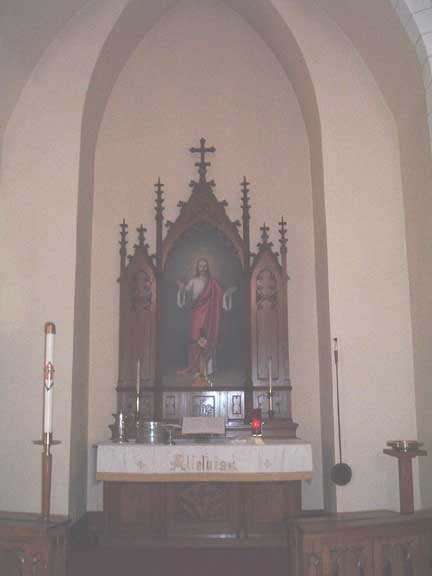
The Altar at Swede Bend Lutheran
To return to the subject of the Franson visit, perhaps it was just this mindset we have described that prevented the Björk group at Swede Bend from enthusiastically embracing this new teaching of independance and autonomy. It had certainly hit the mark elsewhere, both before and since.
But in its own way, the formula that Franson and the "free" movement represented addressed that very mindset as well, and this is important to note. This is a subtlety, but the aversion to "separatism" we have spoken of might well have figured in the Martenson / Princell formula as well, which in its own way avoided all designs to be a denomination at all. By stubbornly rejecting the formation of "denomination" in their midst, they may have attempted to avoid the stigma of one kind of "separatism" as well. Their vision, too, would be altered by the events of time and the inevitable denomination resulted: the Swedish Evangelical Free church.
In any case, it appears that the Björk group stood firmly by the Augustana Lutheran congregation in boycotting the Franson meetings in 1877.